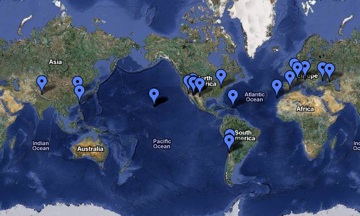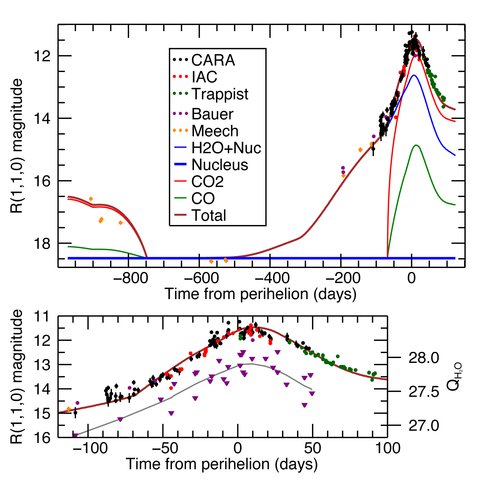2011 Annual Science Report
 University of Hawaii, Manoa
Reporting | SEP 2010 – AUG 2011
University of Hawaii, Manoa
Reporting | SEP 2010 – AUG 2011
Small Body Missions
Project Summary
The team has been active in coordinating and executing Earth-based observations in support of two extended Discovery missions to comets: EPOXI and StardustNExT. These missions re-used the spacecraft from two previously successful missions to fly past new targets. The Earth-based observations were used for mission planning and development, and to give us a time baseline of observations with instruments and at wavelengths not possible during a fast flyby with limited instrumentation. The ground-based and Earth-orbital data plays a critical role in the interpretation and understanding of the in-situ data obtained by the spacecraft. The EPOXI flyby of comet 103P/Hartley 2 on 4 November 2010 revealed a small, highly active comet with CO2-driven jets and a swarm of icy chunks surrounding the nucleus, and the StardustNExT flyby of comet 9P/Tempel 1 on 14 February 2011 allowed us to visit a comet nucleus for the second time to look for changes on the surface after it had made one orbit around the sun.
Project Progress
“Small Body Missions”
There were two mission encounters during this reporting period: The EPOXI encounter with comet 103P/Hartley 2 on 4 November 2010 and the StardustNExT encounter with comet 9P/Tempel 1 on 14 February 2011. PI Meech, a CoI on both missions was in charge of coordinating the Earth-based observing effort for both missions. This included long-term characterization of the nuclei of both mission targets – both to help plan for the missions and as a baseline for activity over a longer time period than possible from the short flyby periods.
EPOXI was the extended Deep Impact mission utilizing the primary Deep Impact spacecraft to fly past a smaller, more active comet nucleus than had been visited before. Our team obtained observations of the comet far from the sun when it was in an inactive state in order to determine the rotation period. This was accomplished using a combination of the Gemini N and S 8-m telescopes and the Hubble Space Telescope, and our team found that the comet was rotating with a period of 16.4 hours. Once the comet became bright enough for smaller telescopes, after developing its tail, others started to monitor the rotation period by analyzing the jet features seen in the dust and gas coma that had originated on the nucleus. Our team coordinated the world-wide observing campaign in support of the mission.

Map of the professional international observing campaign in support of the EPOXI mission leading up to and during the encounter.
Beginning in August 2010 and continuing throughout the fall, and including pre-encounter observations made from the spacecraft, it was clear that the rotation period was changing rapidly, likely from torques induced from the uneven outgassing. Prior to selection as a mission target, it was noted that this comet was unusually active – and a comparison of its surface area with the water production suggested that more than 100 percent of the surface was active. The encounter resolved this puzzling observation by discovering that the comet was surrounded by a swarm of large water-ice chunks that were also releasing gas, thus increasing the effective surface area of the comet. We developed a simple volatile sublimation model using the Earth-based data that showed that carbon dioxide played a very important role in the activity of the comet near perihelion – more than water. This was seen from the spacecraft at flyby and we are now developing a new paradigm for understanding the mechanism for comet activity that may have important implications for the chemistry of these early solar system planetesimals. A first paper has come out in Meech et. al. (2011), and observations and thermal models are being used to explore the evolution of this comet.
Composite photometric light curve of the comet brightness as observed by several teams as a function of time from perihelion. Data from several observers are shown as points, and model contributions from various ices shown as solid lines. The comet became active according to the model, about 500 days before coming to perihelion, and until about 100 days before perihelion water ice sublimation explained this behavior (blue curve). Near perihelion, however, the comet grew even more active, and the CO2 jets started to appear. The bottom inset is an enlargement of the data near perihelion.
The goal of the StardustNExT mission was to execute a second in-situ visit a comet nucleus after it had made one orbit around the sun to look at (1) surface changes caused by the perihelion passage, (2) to image some parts of the nucleus not seen during Deep Impact, and (3) to image the crater made during the Deep Impact experiment. To accomplish this, we needed to have a precise knowledge of the spin state of the comet in spite of the fact that it was changing (slowing down) with time. To this end, a total of 500 whole or partial nights of data were obtained worldwide, in several coordinated observing campaigns, the last during fall 2010. A rotation model was developed which showed that we needed to use all of the spacecraft reserve fuel to adjust the time of arrival in order to accomplish the mission goals. The flyby on 14 February 2011 showed that the predictions had been exactly right, and we met all of the mission objectives. To our surprise the effects of the perihelion passage were more subtle than expected, but we were able to image the impact site from the Deep Impact event. Work continues on the analysis of the space- and ground-based data sets.
Comets provide one of the mechanisms for large-scale transport and delivery of water within our solar system, and asteroids provide another source of volatiles. However, neither comets nor asteroids can explain both Earth’s water and its noble gas inventory. A recently discovered new class of icy bodies in the outer asteroid belt, the Main Belt Comets (MBCs), are comets in near-circular orbits within the asteroid belt. Dynamics suggest they formed in-situ, beyond the primordial snow line, and as such represent a class of icy bodies that formed at a distance from the Sun that has not yet been studied in detail. During 2008-2010 our team developed a Discovery-class mission concept to rendezvous with a main belt comet using an ion propulsion system a state of the art mass spectrometer and an imager and dust analyzer. The mission goals are to (1) provide new knowledge of the history of water in our solar system, (2) contribute to the understanding of the proto-planetary disk structure and dynamics and the location of the snow line, (3) and explore a new class of objects in the main belt.
Publications
-
Belton, M. J. S., Meech, K. J., Chesley, S., Pittichová, J., Carcich, B., Drahus, M., … Zhao, H. (2011). Stardust-NExT, Deep Impact, and the accelerating spin of 9P/Tempel 1. Icarus, 213(1), 345–368. doi:10.1016/j.icarus.2011.01.006
-
Meech, K. J., A’Hearn, M. F., Adams, J. A., Bacci, P., Bai, J., Barrera, L., … Ziffer, J. E. (2011). EPOXI : COMET 103P/HARTLEY 2 OBSERVATIONS FROM A WORLDWIDE CAMPAIGN. The Astrophysical Journal, 734(1), L1. doi:10.1088/2041-8205/734/1/l1
-
Meech, K. J., Pittichová, J., Yang, B., Zenn, A., Belton, M. J. S., A’Hearn, M. F., … Zhao, H. (2011). Deep Impact, Stardust-NExT and the behavior of Comet 9P/Tempel 1 from 1997 to 2010. Icarus, 213(1), 323–344. doi:10.1016/j.icarus.2011.02.016
-
Mumma, M. J., Bonev, B. P., Villanueva, G. L., Paganini, L., DiSanti, M. A., Gibb, E. L., … Magee-Sauer, K. (2011). TEMPORAL AND SPATIAL ASPECTS OF GAS RELEASE DURING THE 2010 APPARITION OF COMET 103P/HARTLEY 2. The Astrophysical Journal, 734(1), L7. doi:10.1088/2041-8205/734/1/l7
-
PROJECT INVESTIGATORS:
-
PROJECT MEMBERS:
Jacqueline Keane
Co-Investigator
Michael Mumma
Co-Investigator
Bhuwan Bhatt
Collaborator
Hermann Boehnhardt
Collaborator
Steve Chesley
Collaborator
Olivier Hainaut
Collaborator
Henry Hsieh
Collaborator
Emmanuel Jehin
Collaborator
Timm Riesen
Postdoc
Gal Sarid
Postdoc
Bin Yang
Postdoc
Heather Kaluna
Graduate Student
Sarah Sonnett
Graduate Student
Anthony Zenn
Graduate Student
-
RELATED OBJECTIVES:
Objective 2.2
Outer Solar System exploration

